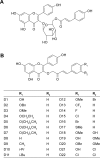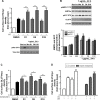AMPK/AS160 mediates tiliroside derivatives-stimulated GLUT4 translocation in muscle cells
- PMID: 29910604
- PMCID: PMC5989705
- DOI: 10.2147/DDDT.S164441
AMPK/AS160 mediates tiliroside derivatives-stimulated GLUT4 translocation in muscle cells
Abstract
Introduction: The Chinese herb Potentilla chinensis can reduce blood glucose level of diabetic mice. Tiliroside is the main effective component, but the detailed mechanism is not clear. Skeletal muscles play an important role in whole body glucose homeostasis. Insulin and exercise/contraction stimulate glucose uptake by muscle cells via redistribution of glucose transporter GLUT4 to the cell surface.
Materials and methods: We explored the effects of tiliroside derivatives on cell surface GLUT4 level (GLUT4 translocation) and the underlying mechanism in L6-GLUT4myc muscle cells.
Results: We showed that tiliroside derivatives D1-22 stimulated GLUT4myc translocation in L6-GLUT4myc skeletal muscle cells. Derivatives D1, D8 and D18 regulated GLUT4myc translocation in a time- and dose-dependent manner. Their effects on GLUT4 were additive with that of acute insulin stimulation. Moreover, they increased phosphorylated adenosine monophosphate-activated protein kinase (AMPK), but not protein kinase B (PKB, also called Akt). Their effects on GLUT4 were inhibited by Compound C. In addition, derivative D8 significantly stimulated AMPK and Akt substrate of 160 kDa (AS160) phosphorylation and GLUT4myc translocation in L6-GLUT4myc cells, but not in L6-AS160 4A-GLUT4myc cells.
Conclusion: Tiliroside derivatives D1, D8 and D18 stimulated GLUT4myc translocation by a mechanism different to that of insulin in skeletal muscle cells. The effect of derivative D8 on GLUT4myc translocation is mediated by AMPK/AS160 signaling pathway.
Keywords: AMPK; insulin resistance; skeletal muscle cells; type 2 diabetes.
Conflict of interest statement
Disclosure The authors report no conflicts of interest in this work.
Figures




References
-
- International Diabetes Federation Q&A: Key points for IDF Diabetes Atlas 2017. Diabetes Res Clin Pract. 2018;135:235–236. - PubMed
-
- Winder WW, Hardie DG. AMP-activated protein kinase, a metabolic master switch: possible roles in Type 2 diabetes. Am J Physiol. 1999;277(1 Pt 1):E1–E10. - PubMed
-
- Klip A. The many ways to regulate glucose transporter 4. Appl Physiol Nutr Metab. 2009;34(3):481–487. - PubMed
-
- Jessen N, Goodyear LJ. Contraction signaling to glucose transport in skeletal muscle. J Appl Physiol. 2005;99(1):330–337. - PubMed
-
- Zhao C, Qiao W, Zhang YW, Lu B, Duan HQ. 委陵菜抗糖尿病有效部位及有效成分的研究 [Study on anti-diabetes active fraction and constituents from Potentilla chinesis] Zhongguo Zhong Yao Za Zhi. 2008;33(6):680–682. Chinese. - PubMed
MeSH terms
Substances
LinkOut - more resources
Full Text Sources
Other Literature Sources
Miscellaneous

